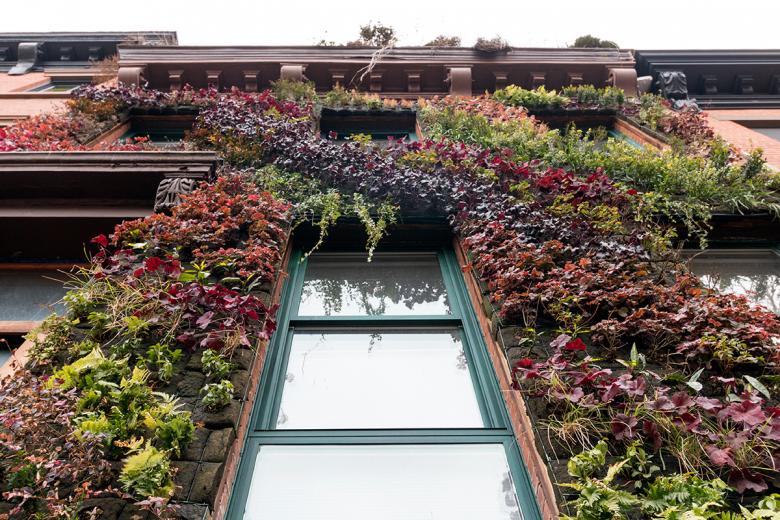A Living Wall Grows in Brooklyn
The Eco Brooklyn Show House is a traditional brick rowhouse with a difference: it's fronted by a living wall. Completed late last year, the Eco Brooklyn Living Wall hopes to set a precedent for the facades of residential buildings in the borough of Brooklyn – and beyond. World-Architects made a visit to see how it works.
With the thermometer just above freezing this second week of January, I wasn't expecting much "living" on the living wall when I made my way to 2nd Street in Brooklyn's Carroll Gardens neighborhood. But as the photos here attest, the Eco Brooklyn Living Wall makes quite a show even in winter. Gennaro Brooks-Church, the brains and brawn behind the living wall and the head of the Eco Brooklyn green building company, explained to me that he populated the three-story wall with evergreens so it would be full of vegetation and visual interest year-round. There are grasses but also coral bells, autumn ferns, and other plants that act like a ground cover but are lifted vertically to cover the front of his family's townhouse.
The installation is made up of three layers in front of the townhouse's brick wall: wood furring strips, PVC board, and the planting medium: "Brownies" made by WaterGrip. The 1-1/2" deep furring strips (spaced every two feet) push the installation away from the wall, provide an air space that makes the living wall act like a rainscreen, and serve as a frame for mounting the PVC boards. The Brownies are attached to the PVC through screws and a grid of wires that together act like a cage for holding the 3" deep substrate made from coconut coir, which insulates the roots and should enable the plants to thrive all year. Tubes running across the facade irrigate the living wall with drips of water two times a day.
As a strong believer in the benefits of living walls (reducing the heat island effect, insulating homes in the winter and cooling them in the summer, creating habitats for butterflies and other insects), Brooks-Church hopes his Eco Brooklyn Living Wall is the first of many in his neighborhood and across the borough. Of course, there are impediments: Much of the low-scale residential fabric in "Brownstone Brooklyn" consists of landmark districts, where adding a green wall to the street would be difficult, if not impossible, due to the approvals required by the Landmarks Preservation Commission. Furthremore, this first installation is, he admits, too labor-instensive for widespread use; and at $200 per square foot (equating to $60,000 for a three-story facade), the Eco Brooklyn Living Wall is not cheap. But Brooks-Church is developing holders for the Brownies that would make it easier and cheaper to install. When that happens, look for more living walls to "grow" in Brooklyn.
Related articles
-
-
-
Domino Sugary Refinery
Practice for Architecture and Urbanism | PAU | 24.06.2024 -
-




